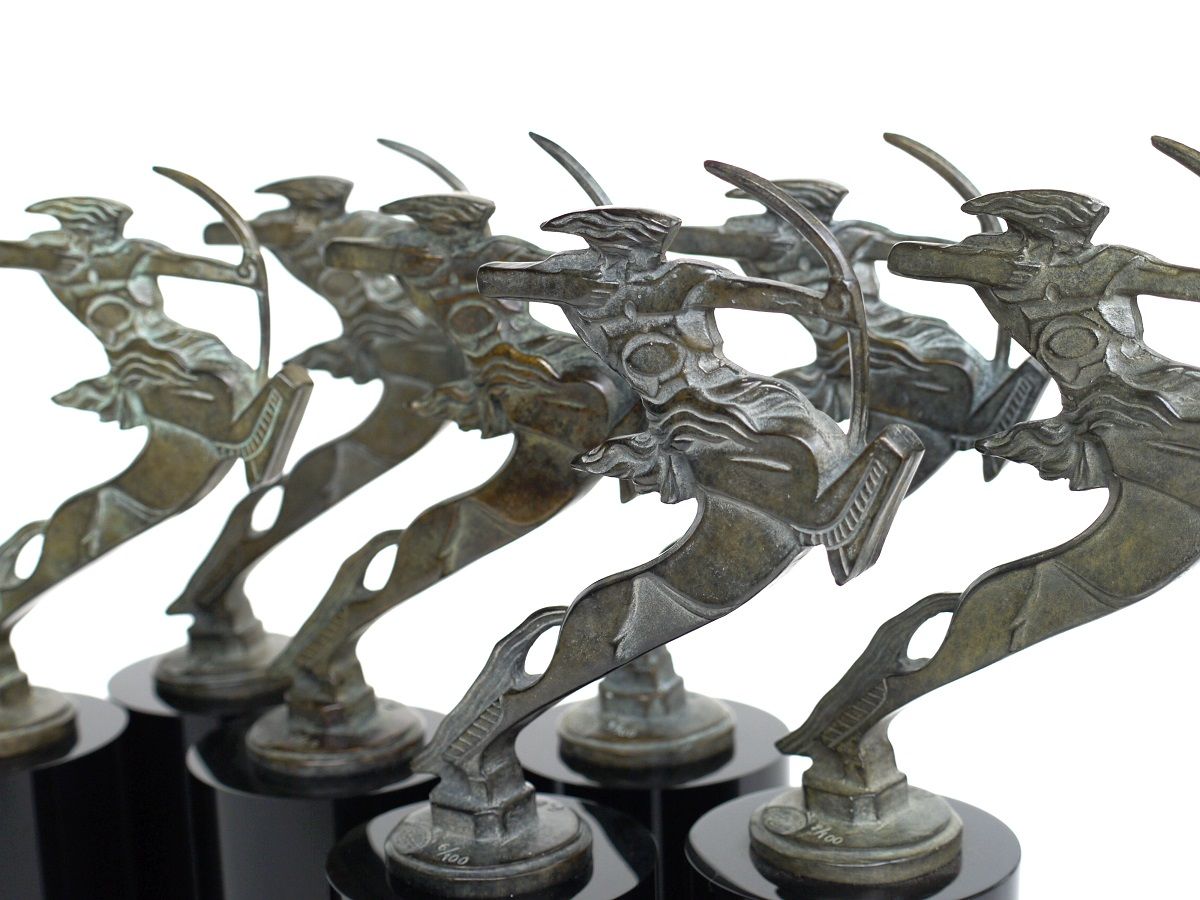François Bazin: One Of The Greats Of Art Deco Mascot Designers
Images: Julie Bazin
Remember the story we carried on the stork mascot of Hispano-Suiza and how it came about, in the 14th of February issue of deRivaz & Ives magazine? In case you don’t, here it is once again: https://magazine.derivaz-ives.com/the-stork-mascot-of-hispano-suiza-the-story-of-how-it-came-about/

That’s when we wrote about the work of François Bazin, a brilliant young French sculptor who was commissioned by the boss of Hispano-Suiza, March Birkigt, to design and sculpt the stork mascot which the carmaker adopted as their official mascot and emblem, after the death of the ace French fighter pilot Georges Guyenemer. The latter was the one who had used the stork as his symbol on the flanks of his Spad fighter aircraft.

François Bazin was born in the 14th arrondissement of Paris on 31st October 1897, to parents who were copper engravers. François’ mother was exceptionally talented, and was the first lady engraver in France, one who competed for the prestigious Prix de Rome. Soon after François Bazin was born, his parents and him moved to Chile, where François grew up, as both his parents had found jobs teaching art at the art school in Santiago. Back in Paris in 1913, François Bazin enrolled into the famous l'École des arts décoratifs and then at l’École nationale supérieure des beaux-arts.

But with the start of the First World War, Bazin was soon mobilized in the aviation wing of the French forces, where he learned to fly a fighter aircraft, specifically becoming a pilot of the Spads which were powered by the Hispano-Suiza V8s. As we know from our earlier story, it was here that he met Marc Birkigt, and the later asked him to design the legendary stork mascot.


That tiny flying stork sculpture became the official hood ornament of the cars of the Franco-Spanish marque. The sculpture was also available in several versions, including one specially produced for the automobile of tennis legend René Lacoste—who was also a brand ambassador for Hispano-Suiza—where the stork holds a tennis ball in its beak.
Over the years the stork mascot as well as the other mascots and sculptures that François Bazin created have commanded very high prices at auctions of automobilia, with one of the mascots fetching a record €5,610 (Rs 4.7 lakhs) at a Christie’s auction in 2016!

There are a variety of equally remarkable examples of the stork, in gilded bronze, with patina or in silver, on a wooden or a marble base, with innumerable options and combinations. The stork though remains one of Bazin's most famous and prized designs at auction, with prices mostly in the four-digit (in euros) range, or close to one lakh rupees or more.


Over a career of almost four decades—Bazin died rather young, at 59, on the 9th of December 1956—the sculptor conceived more than 70 different mascots, some of which were orders from individuals, but many were commissions for other famous brands. His incredible ability to combine curves and angular features gave his creations a very pronounced Art Deco style, as can be seen in works known as the Éléphant-Latil, Pégase, and the famous Triomphe, which was the optional mascot for Italy’s most prestigious automobile marque, Isotta Fraschini.

When André Citroën launched the Croisière Noire to cross the African continent, in 1924, as a brilliant marketing exercise to not just market his brand but to also promote cultural and political exchanges, François Bazin was contacted by the great man himself to design a mascot that would embody the concept.


Bazin designed a startlingly beautiful mascot in the image of the beautiful Nobosudru, the favourite wife of the chief of the Mangbetu tribe, a woman with an extraordinarily graceful posture and an astounding headdress. With her chin up, a smiling and peaceful face atop a long and sinuous neck, complemented by that circular headdress leaning backwards, the sculpture is one that everyone fell in love with. Once again, we see the Art Deco style with curves and sharp edges and certain geometric patterns.


Amongst the other well-known works were the Centaure (Centaur) and the Licorne (Unicorn). Over the years Bazin built up an enviable reputation and he received several awards for fine art and national prizes. In 1929, he won the gold medal at the Salon des artistes français and won the National Prize for his work Aux Bigoudens, Terre de pardons and the Légendes à Pors-Car en Penmarch. He also travelled the world, spending time in Italy, Greece, Egypt, and Madagascar, where he produced statues and made charcoal portraits. He made three decorative bas-reliefs for the Palace of Hydrotherapy at the 1937 l'Exposition Arts et Techniques, in Paris.


Although François Bazin passed away in 1956, his art and work has seen a revival with his granddaughter Julie Bazin taking on the baton, as she has brought the Bazin label up to date by launching limited-edition giant bronzes of his legendary mascots and offering them as numbered pieces of art. A collection of jewellery (www.fbazin.com) inspired by the Croisière Noire has been designed and launched by Julie Bazin, an exciting project which has rekindled the nostalgia of automobile fans, in addition to reaching a female audience as well. But more of this in another story, very soon.




Comments
Sign in or become a deRivaz & Ives member to join the conversation.
Just enter your email below to get a log in link.
